Clinical Risk Management of Fall Risk: A Nursing Care Perspective
VerifiedAdded on 2022/08/25
|9
|2489
|44
Report
AI Summary
This report focuses on the clinical risk management of fall risk in elderly patients, using a case study of a 75-year-old woman with depression admitted to a geriatric care unit. The report details the identification of fall risk factors, including medication side effects (TCA), poor balance, and medical history. It outlines the clinical risk management process, including assessment tools (FRAT, STRATIFY, Timed Up and Go test), analysis of risk factors, evaluation of interventions, and management strategies. The report emphasizes the role of nurses in fall prevention, including regular monitoring, patient education, environmental modifications, and mobility aids. It also discusses the impact of falls on elderly health, including injury, mortality, and healthcare costs, while providing references to relevant policies and guidelines. The report highlights the importance of a comprehensive approach to minimize clinical risk and improve patient safety.
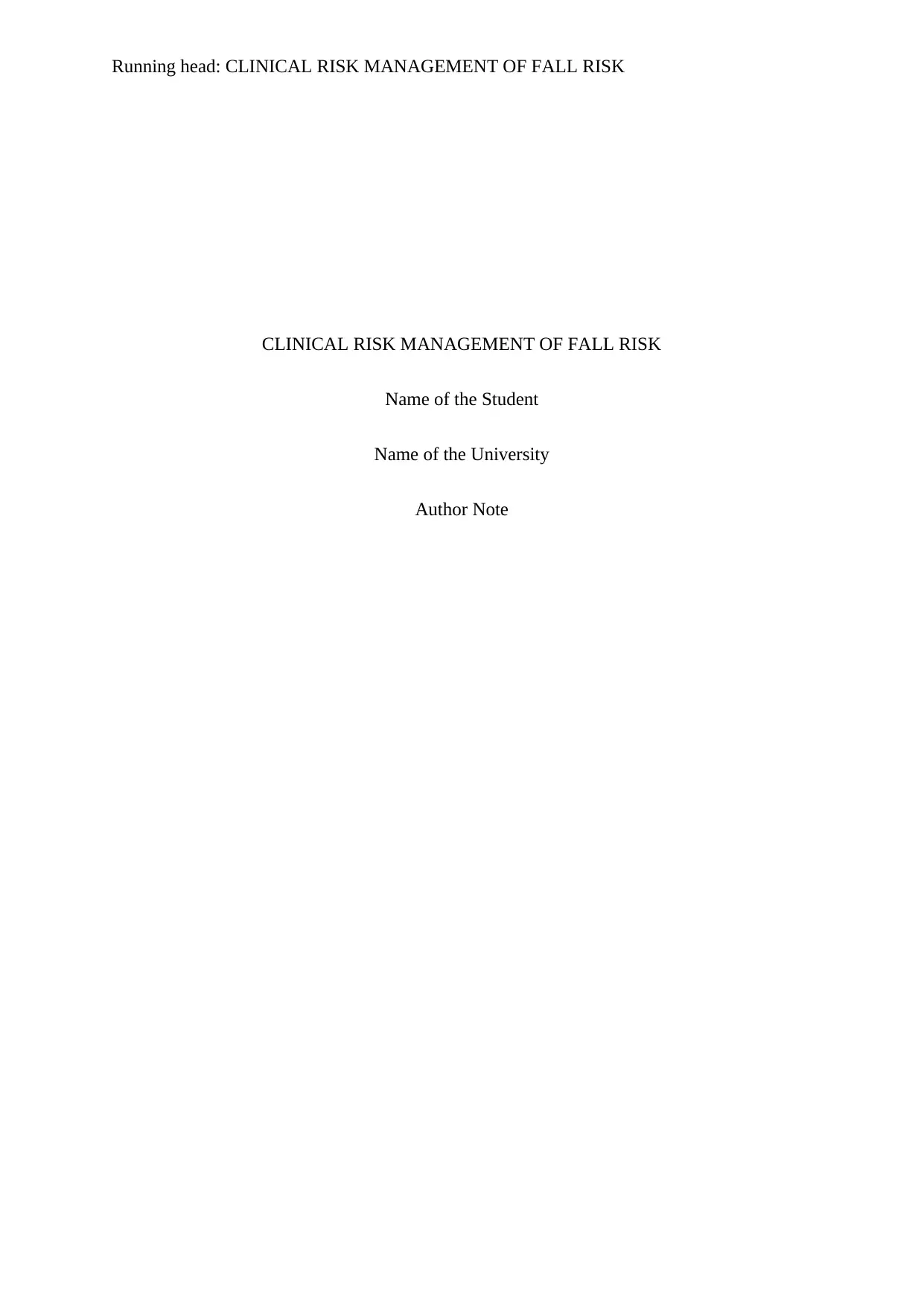
Running head: CLINICAL RISK MANAGEMENT OF FALL RISK
CLINICAL RISK MANAGEMENT OF FALL RISK
Name of the Student
Name of the University
Author Note
CLINICAL RISK MANAGEMENT OF FALL RISK
Name of the Student
Name of the University
Author Note
Paraphrase This Document
Need a fresh take? Get an instant paraphrase of this document with our AI Paraphraser
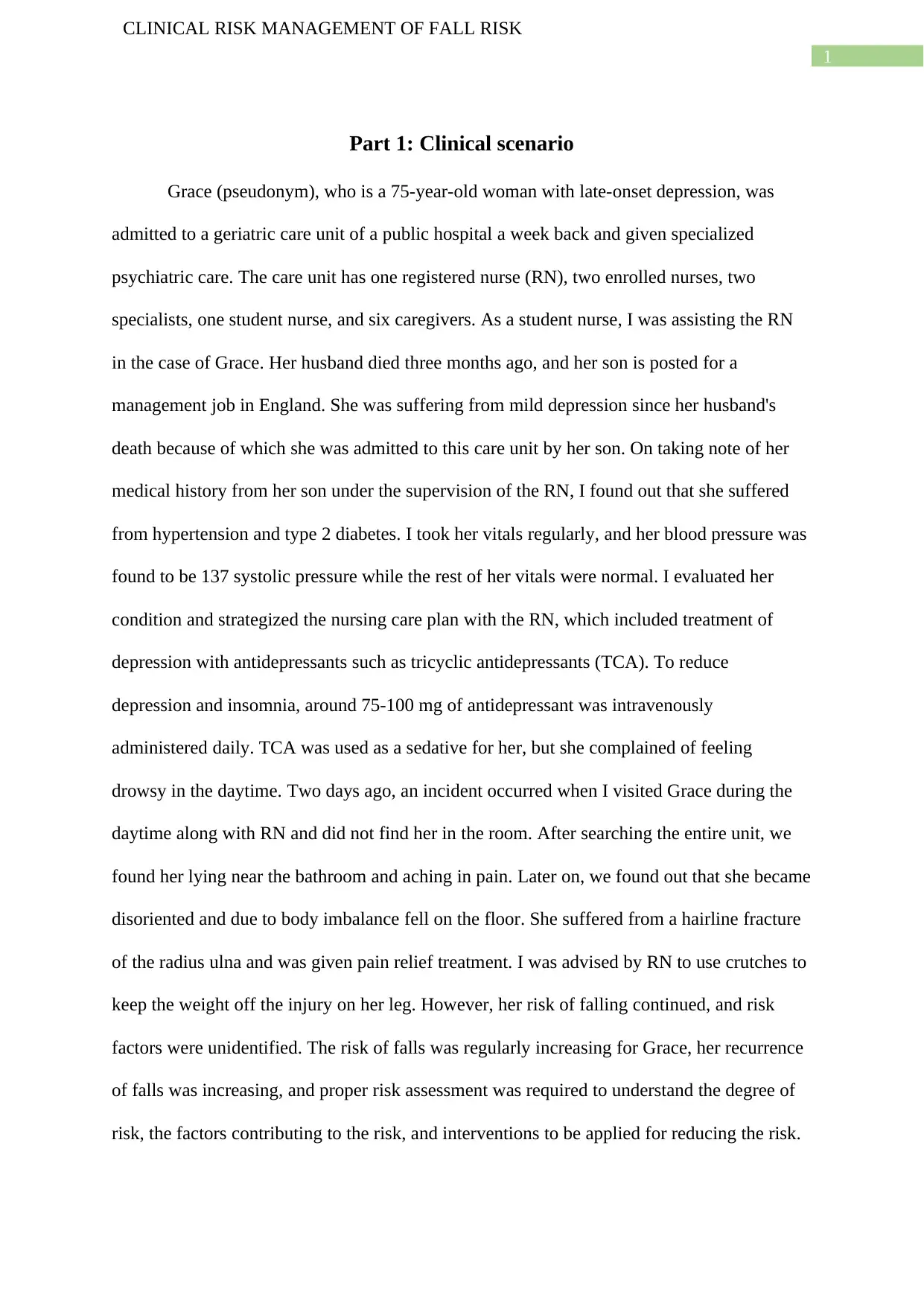
1
CLINICAL RISK MANAGEMENT OF FALL RISK
Part 1: Clinical scenario
Grace (pseudonym), who is a 75-year-old woman with late-onset depression, was
admitted to a geriatric care unit of a public hospital a week back and given specialized
psychiatric care. The care unit has one registered nurse (RN), two enrolled nurses, two
specialists, one student nurse, and six caregivers. As a student nurse, I was assisting the RN
in the case of Grace. Her husband died three months ago, and her son is posted for a
management job in England. She was suffering from mild depression since her husband's
death because of which she was admitted to this care unit by her son. On taking note of her
medical history from her son under the supervision of the RN, I found out that she suffered
from hypertension and type 2 diabetes. I took her vitals regularly, and her blood pressure was
found to be 137 systolic pressure while the rest of her vitals were normal. I evaluated her
condition and strategized the nursing care plan with the RN, which included treatment of
depression with antidepressants such as tricyclic antidepressants (TCA). To reduce
depression and insomnia, around 75-100 mg of antidepressant was intravenously
administered daily. TCA was used as a sedative for her, but she complained of feeling
drowsy in the daytime. Two days ago, an incident occurred when I visited Grace during the
daytime along with RN and did not find her in the room. After searching the entire unit, we
found her lying near the bathroom and aching in pain. Later on, we found out that she became
disoriented and due to body imbalance fell on the floor. She suffered from a hairline fracture
of the radius ulna and was given pain relief treatment. I was advised by RN to use crutches to
keep the weight off the injury on her leg. However, her risk of falling continued, and risk
factors were unidentified. The risk of falls was regularly increasing for Grace, her recurrence
of falls was increasing, and proper risk assessment was required to understand the degree of
risk, the factors contributing to the risk, and interventions to be applied for reducing the risk.
CLINICAL RISK MANAGEMENT OF FALL RISK
Part 1: Clinical scenario
Grace (pseudonym), who is a 75-year-old woman with late-onset depression, was
admitted to a geriatric care unit of a public hospital a week back and given specialized
psychiatric care. The care unit has one registered nurse (RN), two enrolled nurses, two
specialists, one student nurse, and six caregivers. As a student nurse, I was assisting the RN
in the case of Grace. Her husband died three months ago, and her son is posted for a
management job in England. She was suffering from mild depression since her husband's
death because of which she was admitted to this care unit by her son. On taking note of her
medical history from her son under the supervision of the RN, I found out that she suffered
from hypertension and type 2 diabetes. I took her vitals regularly, and her blood pressure was
found to be 137 systolic pressure while the rest of her vitals were normal. I evaluated her
condition and strategized the nursing care plan with the RN, which included treatment of
depression with antidepressants such as tricyclic antidepressants (TCA). To reduce
depression and insomnia, around 75-100 mg of antidepressant was intravenously
administered daily. TCA was used as a sedative for her, but she complained of feeling
drowsy in the daytime. Two days ago, an incident occurred when I visited Grace during the
daytime along with RN and did not find her in the room. After searching the entire unit, we
found her lying near the bathroom and aching in pain. Later on, we found out that she became
disoriented and due to body imbalance fell on the floor. She suffered from a hairline fracture
of the radius ulna and was given pain relief treatment. I was advised by RN to use crutches to
keep the weight off the injury on her leg. However, her risk of falling continued, and risk
factors were unidentified. The risk of falls was regularly increasing for Grace, her recurrence
of falls was increasing, and proper risk assessment was required to understand the degree of
risk, the factors contributing to the risk, and interventions to be applied for reducing the risk.
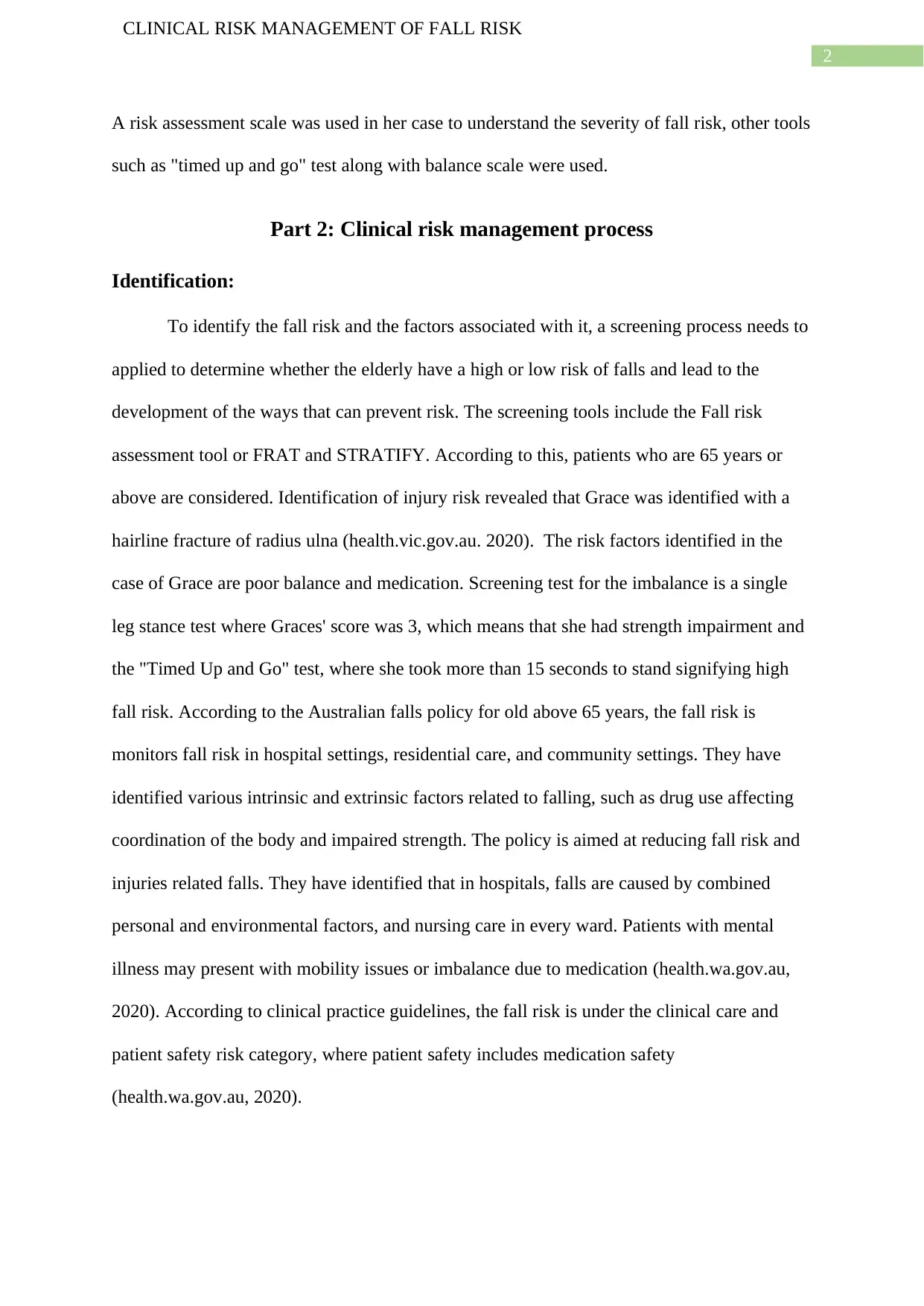
2
CLINICAL RISK MANAGEMENT OF FALL RISK
A risk assessment scale was used in her case to understand the severity of fall risk, other tools
such as "timed up and go" test along with balance scale were used.
Part 2: Clinical risk management process
Identification:
To identify the fall risk and the factors associated with it, a screening process needs to
applied to determine whether the elderly have a high or low risk of falls and lead to the
development of the ways that can prevent risk. The screening tools include the Fall risk
assessment tool or FRAT and STRATIFY. According to this, patients who are 65 years or
above are considered. Identification of injury risk revealed that Grace was identified with a
hairline fracture of radius ulna (health.vic.gov.au. 2020). The risk factors identified in the
case of Grace are poor balance and medication. Screening test for the imbalance is a single
leg stance test where Graces' score was 3, which means that she had strength impairment and
the "Timed Up and Go" test, where she took more than 15 seconds to stand signifying high
fall risk. According to the Australian falls policy for old above 65 years, the fall risk is
monitors fall risk in hospital settings, residential care, and community settings. They have
identified various intrinsic and extrinsic factors related to falling, such as drug use affecting
coordination of the body and impaired strength. The policy is aimed at reducing fall risk and
injuries related falls. They have identified that in hospitals, falls are caused by combined
personal and environmental factors, and nursing care in every ward. Patients with mental
illness may present with mobility issues or imbalance due to medication (health.wa.gov.au,
2020). According to clinical practice guidelines, the fall risk is under the clinical care and
patient safety risk category, where patient safety includes medication safety
(health.wa.gov.au, 2020).
CLINICAL RISK MANAGEMENT OF FALL RISK
A risk assessment scale was used in her case to understand the severity of fall risk, other tools
such as "timed up and go" test along with balance scale were used.
Part 2: Clinical risk management process
Identification:
To identify the fall risk and the factors associated with it, a screening process needs to
applied to determine whether the elderly have a high or low risk of falls and lead to the
development of the ways that can prevent risk. The screening tools include the Fall risk
assessment tool or FRAT and STRATIFY. According to this, patients who are 65 years or
above are considered. Identification of injury risk revealed that Grace was identified with a
hairline fracture of radius ulna (health.vic.gov.au. 2020). The risk factors identified in the
case of Grace are poor balance and medication. Screening test for the imbalance is a single
leg stance test where Graces' score was 3, which means that she had strength impairment and
the "Timed Up and Go" test, where she took more than 15 seconds to stand signifying high
fall risk. According to the Australian falls policy for old above 65 years, the fall risk is
monitors fall risk in hospital settings, residential care, and community settings. They have
identified various intrinsic and extrinsic factors related to falling, such as drug use affecting
coordination of the body and impaired strength. The policy is aimed at reducing fall risk and
injuries related falls. They have identified that in hospitals, falls are caused by combined
personal and environmental factors, and nursing care in every ward. Patients with mental
illness may present with mobility issues or imbalance due to medication (health.wa.gov.au,
2020). According to clinical practice guidelines, the fall risk is under the clinical care and
patient safety risk category, where patient safety includes medication safety
(health.wa.gov.au, 2020).
⊘ This is a preview!⊘
Do you want full access?
Subscribe today to unlock all pages.

Trusted by 1+ million students worldwide
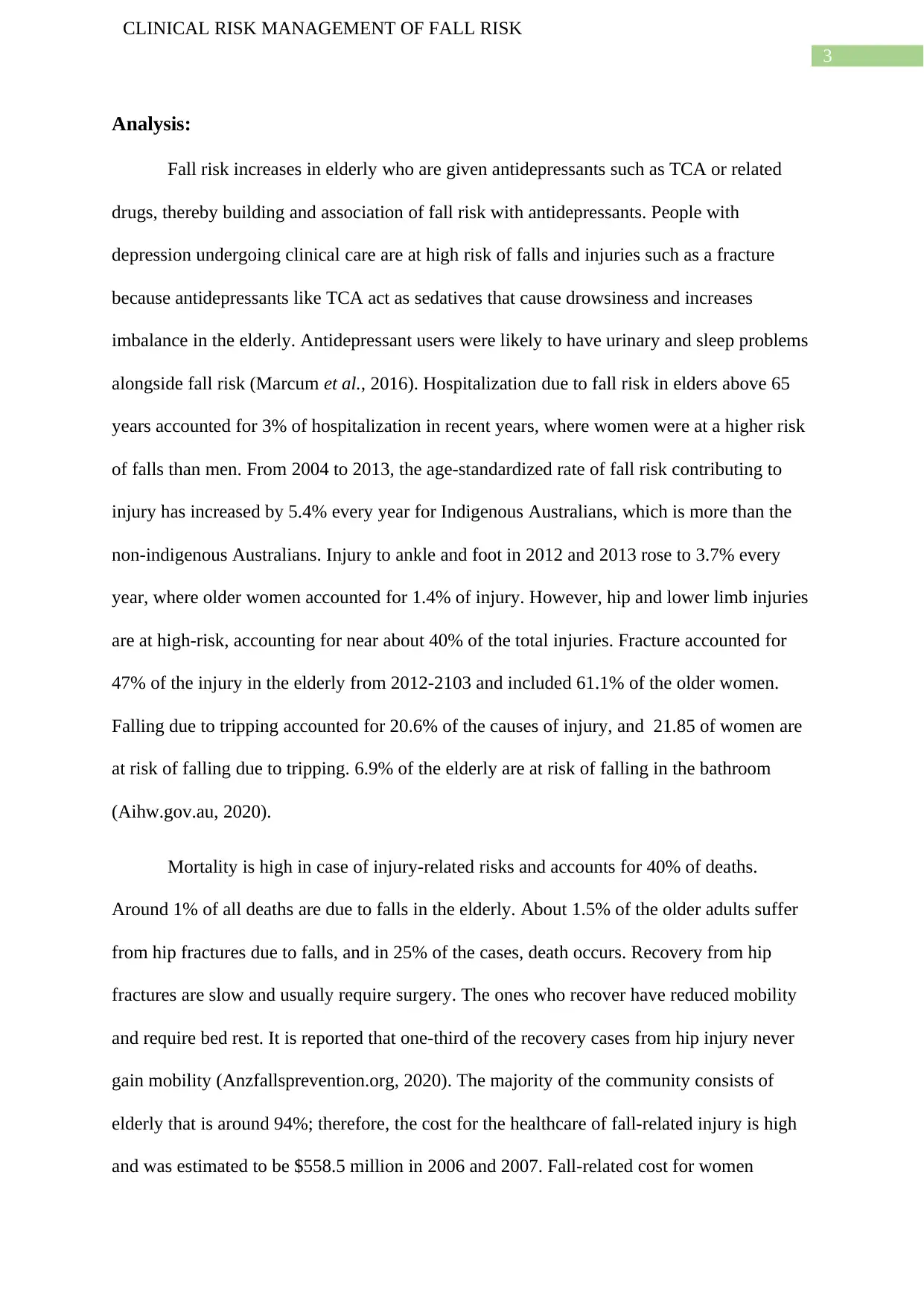
3
CLINICAL RISK MANAGEMENT OF FALL RISK
Analysis:
Fall risk increases in elderly who are given antidepressants such as TCA or related
drugs, thereby building and association of fall risk with antidepressants. People with
depression undergoing clinical care are at high risk of falls and injuries such as a fracture
because antidepressants like TCA act as sedatives that cause drowsiness and increases
imbalance in the elderly. Antidepressant users were likely to have urinary and sleep problems
alongside fall risk (Marcum et al., 2016). Hospitalization due to fall risk in elders above 65
years accounted for 3% of hospitalization in recent years, where women were at a higher risk
of falls than men. From 2004 to 2013, the age-standardized rate of fall risk contributing to
injury has increased by 5.4% every year for Indigenous Australians, which is more than the
non-indigenous Australians. Injury to ankle and foot in 2012 and 2013 rose to 3.7% every
year, where older women accounted for 1.4% of injury. However, hip and lower limb injuries
are at high-risk, accounting for near about 40% of the total injuries. Fracture accounted for
47% of the injury in the elderly from 2012-2103 and included 61.1% of the older women.
Falling due to tripping accounted for 20.6% of the causes of injury, and 21.85 of women are
at risk of falling due to tripping. 6.9% of the elderly are at risk of falling in the bathroom
(Aihw.gov.au, 2020).
Mortality is high in case of injury-related risks and accounts for 40% of deaths.
Around 1% of all deaths are due to falls in the elderly. About 1.5% of the older adults suffer
from hip fractures due to falls, and in 25% of the cases, death occurs. Recovery from hip
fractures are slow and usually require surgery. The ones who recover have reduced mobility
and require bed rest. It is reported that one-third of the recovery cases from hip injury never
gain mobility (Anzfallsprevention.org, 2020). The majority of the community consists of
elderly that is around 94%; therefore, the cost for the healthcare of fall-related injury is high
and was estimated to be $558.5 million in 2006 and 2007. Fall-related cost for women
CLINICAL RISK MANAGEMENT OF FALL RISK
Analysis:
Fall risk increases in elderly who are given antidepressants such as TCA or related
drugs, thereby building and association of fall risk with antidepressants. People with
depression undergoing clinical care are at high risk of falls and injuries such as a fracture
because antidepressants like TCA act as sedatives that cause drowsiness and increases
imbalance in the elderly. Antidepressant users were likely to have urinary and sleep problems
alongside fall risk (Marcum et al., 2016). Hospitalization due to fall risk in elders above 65
years accounted for 3% of hospitalization in recent years, where women were at a higher risk
of falls than men. From 2004 to 2013, the age-standardized rate of fall risk contributing to
injury has increased by 5.4% every year for Indigenous Australians, which is more than the
non-indigenous Australians. Injury to ankle and foot in 2012 and 2013 rose to 3.7% every
year, where older women accounted for 1.4% of injury. However, hip and lower limb injuries
are at high-risk, accounting for near about 40% of the total injuries. Fracture accounted for
47% of the injury in the elderly from 2012-2103 and included 61.1% of the older women.
Falling due to tripping accounted for 20.6% of the causes of injury, and 21.85 of women are
at risk of falling due to tripping. 6.9% of the elderly are at risk of falling in the bathroom
(Aihw.gov.au, 2020).
Mortality is high in case of injury-related risks and accounts for 40% of deaths.
Around 1% of all deaths are due to falls in the elderly. About 1.5% of the older adults suffer
from hip fractures due to falls, and in 25% of the cases, death occurs. Recovery from hip
fractures are slow and usually require surgery. The ones who recover have reduced mobility
and require bed rest. It is reported that one-third of the recovery cases from hip injury never
gain mobility (Anzfallsprevention.org, 2020). The majority of the community consists of
elderly that is around 94%; therefore, the cost for the healthcare of fall-related injury is high
and was estimated to be $558.5 million in 2006 and 2007. Fall-related cost for women
Paraphrase This Document
Need a fresh take? Get an instant paraphrase of this document with our AI Paraphraser
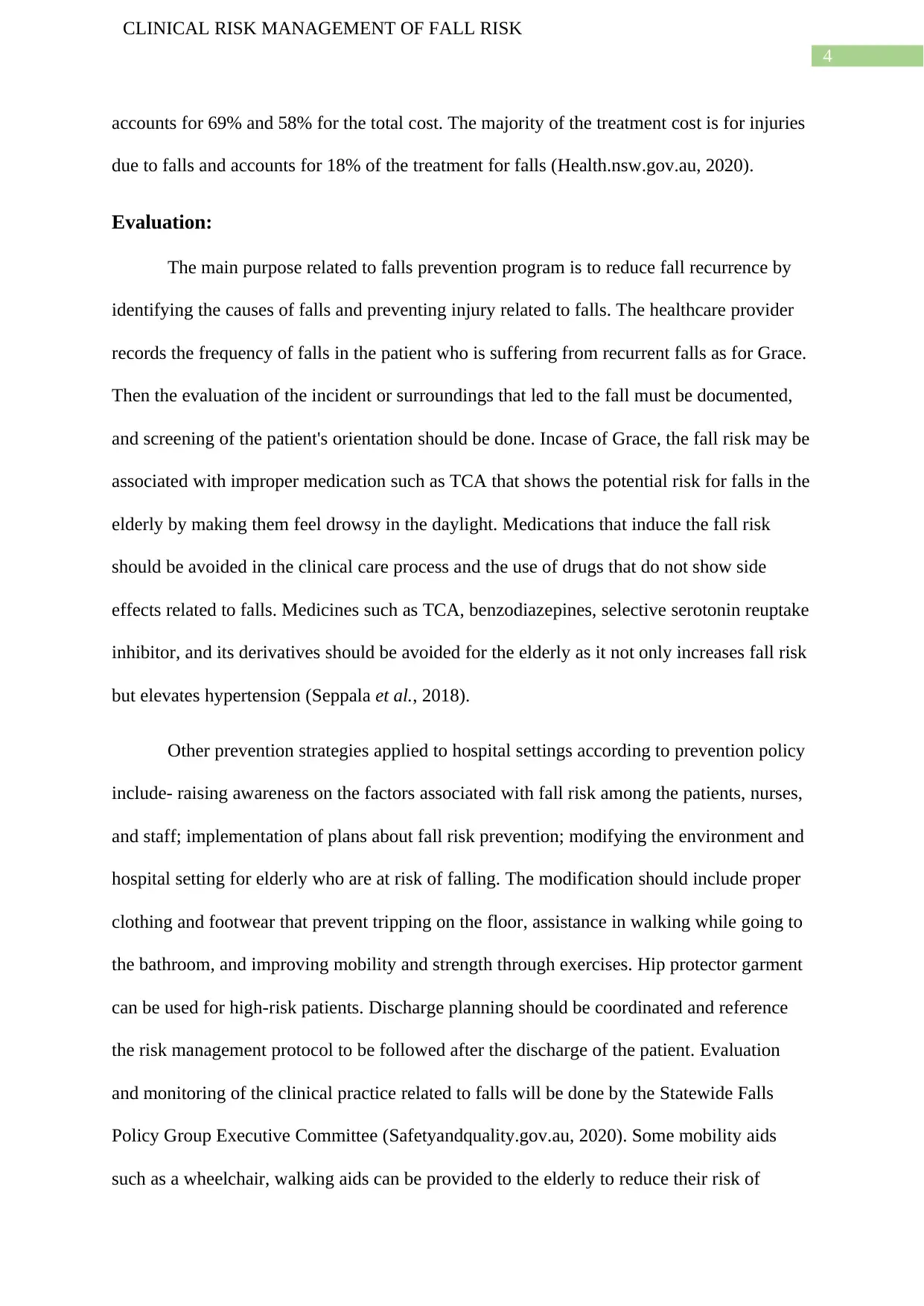
4
CLINICAL RISK MANAGEMENT OF FALL RISK
accounts for 69% and 58% for the total cost. The majority of the treatment cost is for injuries
due to falls and accounts for 18% of the treatment for falls (Health.nsw.gov.au, 2020).
Evaluation:
The main purpose related to falls prevention program is to reduce fall recurrence by
identifying the causes of falls and preventing injury related to falls. The healthcare provider
records the frequency of falls in the patient who is suffering from recurrent falls as for Grace.
Then the evaluation of the incident or surroundings that led to the fall must be documented,
and screening of the patient's orientation should be done. Incase of Grace, the fall risk may be
associated with improper medication such as TCA that shows the potential risk for falls in the
elderly by making them feel drowsy in the daylight. Medications that induce the fall risk
should be avoided in the clinical care process and the use of drugs that do not show side
effects related to falls. Medicines such as TCA, benzodiazepines, selective serotonin reuptake
inhibitor, and its derivatives should be avoided for the elderly as it not only increases fall risk
but elevates hypertension (Seppala et al., 2018).
Other prevention strategies applied to hospital settings according to prevention policy
include- raising awareness on the factors associated with fall risk among the patients, nurses,
and staff; implementation of plans about fall risk prevention; modifying the environment and
hospital setting for elderly who are at risk of falling. The modification should include proper
clothing and footwear that prevent tripping on the floor, assistance in walking while going to
the bathroom, and improving mobility and strength through exercises. Hip protector garment
can be used for high-risk patients. Discharge planning should be coordinated and reference
the risk management protocol to be followed after the discharge of the patient. Evaluation
and monitoring of the clinical practice related to falls will be done by the Statewide Falls
Policy Group Executive Committee (Safetyandquality.gov.au, 2020). Some mobility aids
such as a wheelchair, walking aids can be provided to the elderly to reduce their risk of
CLINICAL RISK MANAGEMENT OF FALL RISK
accounts for 69% and 58% for the total cost. The majority of the treatment cost is for injuries
due to falls and accounts for 18% of the treatment for falls (Health.nsw.gov.au, 2020).
Evaluation:
The main purpose related to falls prevention program is to reduce fall recurrence by
identifying the causes of falls and preventing injury related to falls. The healthcare provider
records the frequency of falls in the patient who is suffering from recurrent falls as for Grace.
Then the evaluation of the incident or surroundings that led to the fall must be documented,
and screening of the patient's orientation should be done. Incase of Grace, the fall risk may be
associated with improper medication such as TCA that shows the potential risk for falls in the
elderly by making them feel drowsy in the daylight. Medications that induce the fall risk
should be avoided in the clinical care process and the use of drugs that do not show side
effects related to falls. Medicines such as TCA, benzodiazepines, selective serotonin reuptake
inhibitor, and its derivatives should be avoided for the elderly as it not only increases fall risk
but elevates hypertension (Seppala et al., 2018).
Other prevention strategies applied to hospital settings according to prevention policy
include- raising awareness on the factors associated with fall risk among the patients, nurses,
and staff; implementation of plans about fall risk prevention; modifying the environment and
hospital setting for elderly who are at risk of falling. The modification should include proper
clothing and footwear that prevent tripping on the floor, assistance in walking while going to
the bathroom, and improving mobility and strength through exercises. Hip protector garment
can be used for high-risk patients. Discharge planning should be coordinated and reference
the risk management protocol to be followed after the discharge of the patient. Evaluation
and monitoring of the clinical practice related to falls will be done by the Statewide Falls
Policy Group Executive Committee (Safetyandquality.gov.au, 2020). Some mobility aids
such as a wheelchair, walking aids can be provided to the elderly to reduce their risk of
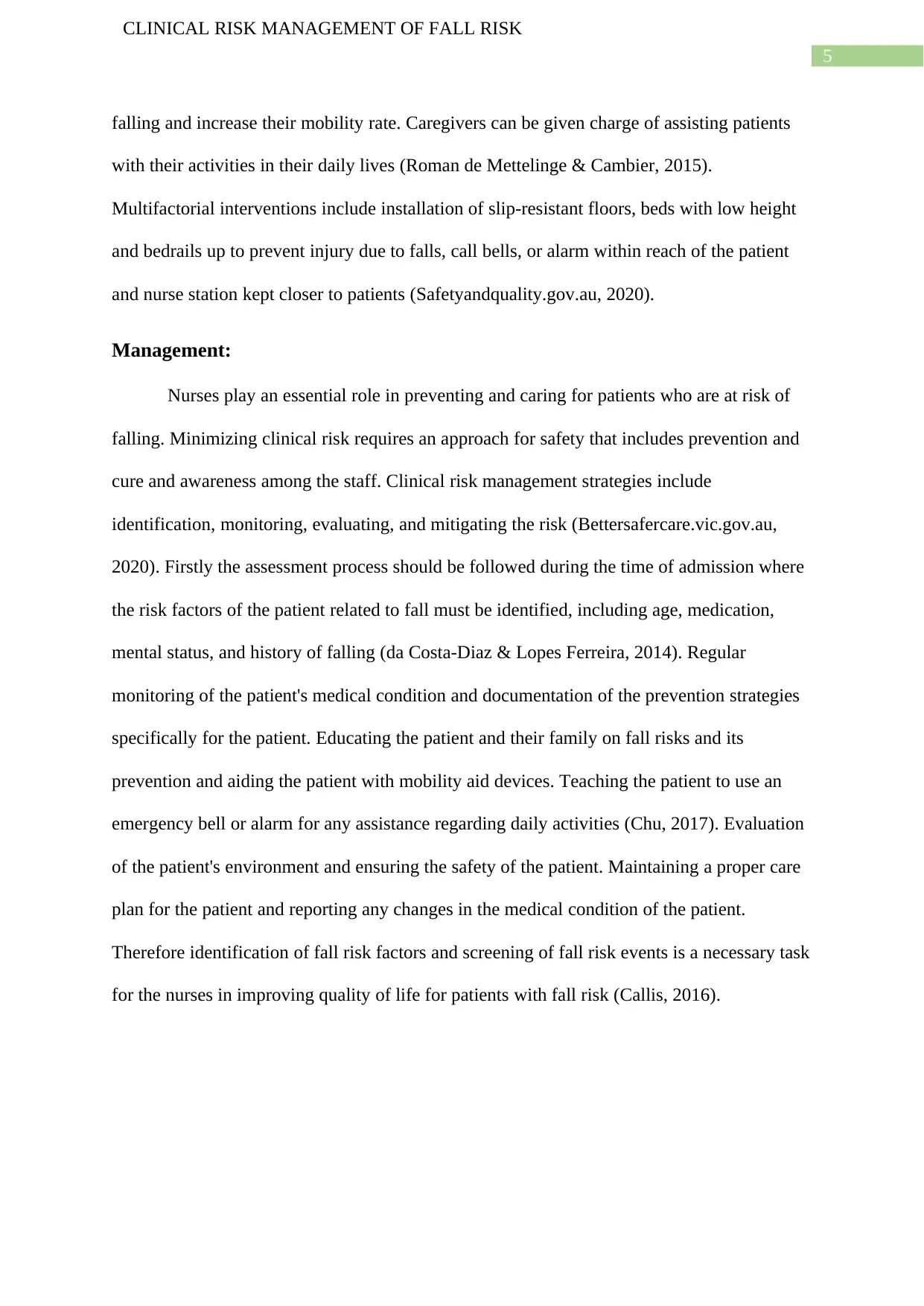
5
CLINICAL RISK MANAGEMENT OF FALL RISK
falling and increase their mobility rate. Caregivers can be given charge of assisting patients
with their activities in their daily lives (Roman de Mettelinge & Cambier, 2015).
Multifactorial interventions include installation of slip-resistant floors, beds with low height
and bedrails up to prevent injury due to falls, call bells, or alarm within reach of the patient
and nurse station kept closer to patients (Safetyandquality.gov.au, 2020).
Management:
Nurses play an essential role in preventing and caring for patients who are at risk of
falling. Minimizing clinical risk requires an approach for safety that includes prevention and
cure and awareness among the staff. Clinical risk management strategies include
identification, monitoring, evaluating, and mitigating the risk (Bettersafercare.vic.gov.au,
2020). Firstly the assessment process should be followed during the time of admission where
the risk factors of the patient related to fall must be identified, including age, medication,
mental status, and history of falling (da Costa-Diaz & Lopes Ferreira, 2014). Regular
monitoring of the patient's medical condition and documentation of the prevention strategies
specifically for the patient. Educating the patient and their family on fall risks and its
prevention and aiding the patient with mobility aid devices. Teaching the patient to use an
emergency bell or alarm for any assistance regarding daily activities (Chu, 2017). Evaluation
of the patient's environment and ensuring the safety of the patient. Maintaining a proper care
plan for the patient and reporting any changes in the medical condition of the patient.
Therefore identification of fall risk factors and screening of fall risk events is a necessary task
for the nurses in improving quality of life for patients with fall risk (Callis, 2016).
CLINICAL RISK MANAGEMENT OF FALL RISK
falling and increase their mobility rate. Caregivers can be given charge of assisting patients
with their activities in their daily lives (Roman de Mettelinge & Cambier, 2015).
Multifactorial interventions include installation of slip-resistant floors, beds with low height
and bedrails up to prevent injury due to falls, call bells, or alarm within reach of the patient
and nurse station kept closer to patients (Safetyandquality.gov.au, 2020).
Management:
Nurses play an essential role in preventing and caring for patients who are at risk of
falling. Minimizing clinical risk requires an approach for safety that includes prevention and
cure and awareness among the staff. Clinical risk management strategies include
identification, monitoring, evaluating, and mitigating the risk (Bettersafercare.vic.gov.au,
2020). Firstly the assessment process should be followed during the time of admission where
the risk factors of the patient related to fall must be identified, including age, medication,
mental status, and history of falling (da Costa-Diaz & Lopes Ferreira, 2014). Regular
monitoring of the patient's medical condition and documentation of the prevention strategies
specifically for the patient. Educating the patient and their family on fall risks and its
prevention and aiding the patient with mobility aid devices. Teaching the patient to use an
emergency bell or alarm for any assistance regarding daily activities (Chu, 2017). Evaluation
of the patient's environment and ensuring the safety of the patient. Maintaining a proper care
plan for the patient and reporting any changes in the medical condition of the patient.
Therefore identification of fall risk factors and screening of fall risk events is a necessary task
for the nurses in improving quality of life for patients with fall risk (Callis, 2016).
⊘ This is a preview!⊘
Do you want full access?
Subscribe today to unlock all pages.

Trusted by 1+ million students worldwide
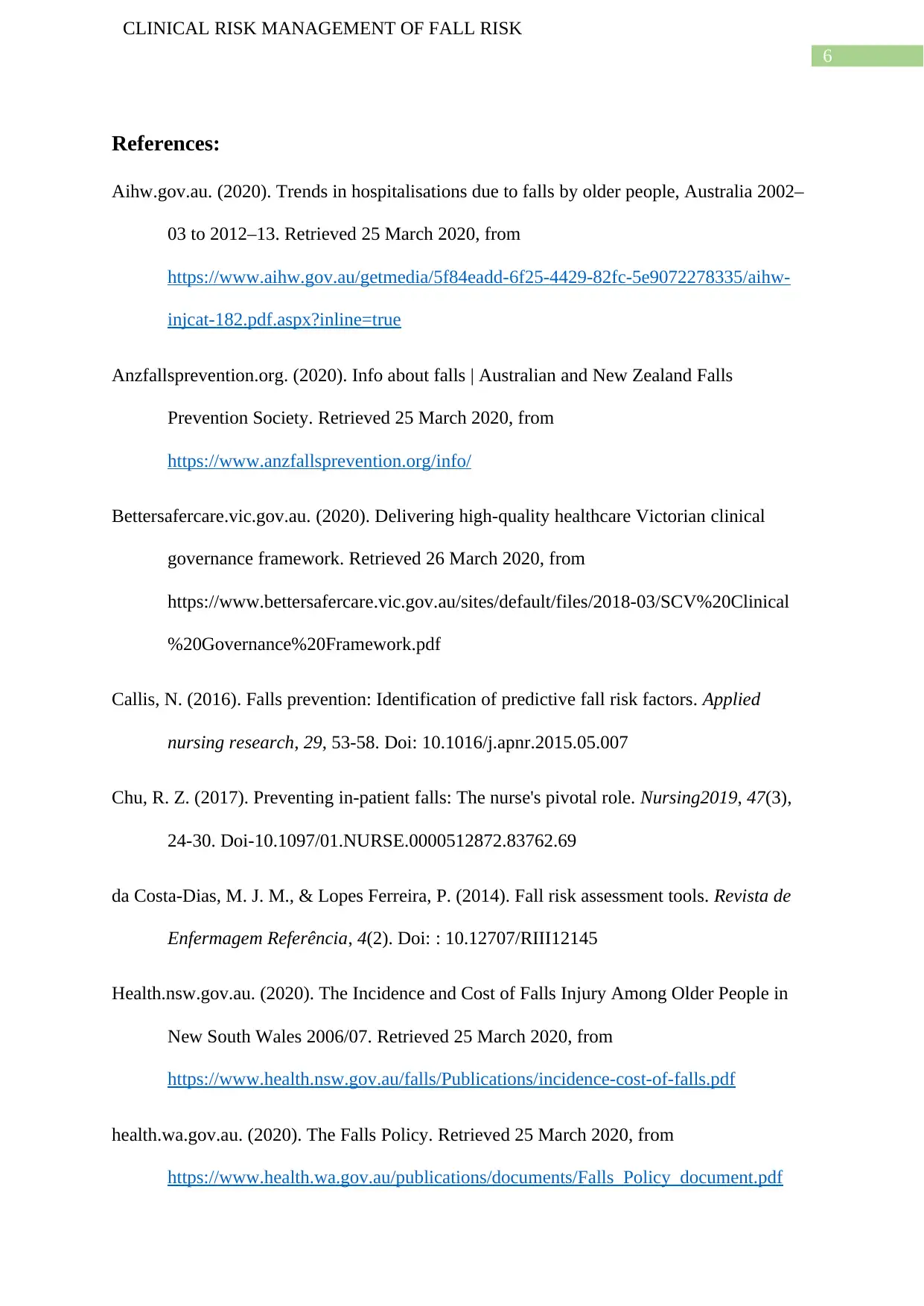
6
CLINICAL RISK MANAGEMENT OF FALL RISK
References:
Aihw.gov.au. (2020). Trends in hospitalisations due to falls by older people, Australia 2002–
03 to 2012–13. Retrieved 25 March 2020, from
https://www.aihw.gov.au/getmedia/5f84eadd-6f25-4429-82fc-5e9072278335/aihw-
injcat-182.pdf.aspx?inline=true
Anzfallsprevention.org. (2020). Info about falls | Australian and New Zealand Falls
Prevention Society. Retrieved 25 March 2020, from
https://www.anzfallsprevention.org/info/
Bettersafercare.vic.gov.au. (2020). Delivering high-quality healthcare Victorian clinical
governance framework. Retrieved 26 March 2020, from
https://www.bettersafercare.vic.gov.au/sites/default/files/2018-03/SCV%20Clinical
%20Governance%20Framework.pdf
Callis, N. (2016). Falls prevention: Identification of predictive fall risk factors. Applied
nursing research, 29, 53-58. Doi: 10.1016/j.apnr.2015.05.007
Chu, R. Z. (2017). Preventing in-patient falls: The nurse's pivotal role. Nursing2019, 47(3),
24-30. Doi-10.1097/01.NURSE.0000512872.83762.69
da Costa-Dias, M. J. M., & Lopes Ferreira, P. (2014). Fall risk assessment tools. Revista de
Enfermagem Referência, 4(2). Doi: : 10.12707/RIII12145
Health.nsw.gov.au. (2020). The Incidence and Cost of Falls Injury Among Older People in
New South Wales 2006/07. Retrieved 25 March 2020, from
https://www.health.nsw.gov.au/falls/Publications/incidence-cost-of-falls.pdf
health.wa.gov.au. (2020). The Falls Policy. Retrieved 25 March 2020, from
https://www.health.wa.gov.au/publications/documents/Falls_Policy_document.pdf
CLINICAL RISK MANAGEMENT OF FALL RISK
References:
Aihw.gov.au. (2020). Trends in hospitalisations due to falls by older people, Australia 2002–
03 to 2012–13. Retrieved 25 March 2020, from
https://www.aihw.gov.au/getmedia/5f84eadd-6f25-4429-82fc-5e9072278335/aihw-
injcat-182.pdf.aspx?inline=true
Anzfallsprevention.org. (2020). Info about falls | Australian and New Zealand Falls
Prevention Society. Retrieved 25 March 2020, from
https://www.anzfallsprevention.org/info/
Bettersafercare.vic.gov.au. (2020). Delivering high-quality healthcare Victorian clinical
governance framework. Retrieved 26 March 2020, from
https://www.bettersafercare.vic.gov.au/sites/default/files/2018-03/SCV%20Clinical
%20Governance%20Framework.pdf
Callis, N. (2016). Falls prevention: Identification of predictive fall risk factors. Applied
nursing research, 29, 53-58. Doi: 10.1016/j.apnr.2015.05.007
Chu, R. Z. (2017). Preventing in-patient falls: The nurse's pivotal role. Nursing2019, 47(3),
24-30. Doi-10.1097/01.NURSE.0000512872.83762.69
da Costa-Dias, M. J. M., & Lopes Ferreira, P. (2014). Fall risk assessment tools. Revista de
Enfermagem Referência, 4(2). Doi: : 10.12707/RIII12145
Health.nsw.gov.au. (2020). The Incidence and Cost of Falls Injury Among Older People in
New South Wales 2006/07. Retrieved 25 March 2020, from
https://www.health.nsw.gov.au/falls/Publications/incidence-cost-of-falls.pdf
health.wa.gov.au. (2020). The Falls Policy. Retrieved 25 March 2020, from
https://www.health.wa.gov.au/publications/documents/Falls_Policy_document.pdf
Paraphrase This Document
Need a fresh take? Get an instant paraphrase of this document with our AI Paraphraser

7
CLINICAL RISK MANAGEMENT OF FALL RISK
Marcum, Z. A., Perera, S., Thorpe, J. M., Switzer, G. E., Castle, N. G., Strotmeyer, E. S.,
Simonsick, E. M., Ayonayon, H. N., Phillips, C. L., Rubin, S., Zucker-Levin, A. R.,
Bauer, D. C., Shorr, R. I., Kang, Y., Gray, S. L., Hanlon, J. T., & Health ABC Study
(2016). Antidepressant Use and Recurrent Falls in Community-Dwelling Older
Adults: Findings From the Health ABC Study. The Annals of
pharmacotherapy, 50(7), 525–533. https://doi.org/10.1177/1060028016644466
Racgp.org.au. (2020). RACGP - Falls prevention in older adults – assessment and
management. Retrieved 25 March 2020, from
https://www.racgp.org.au/afp/2012/december/falls-prevention/
Roman de Mettelinge, T., & Cambier, D. (2015). Understanding the relationship between
walking aids and falls in older adults: a prospective cohort study. Journal of geriatric
physical therapy, 38(3), 127-132.
Doi: https://doi.org/10.1519/JPT.0000000000000031
Safetyandquality.gov.au. (2020). Preventing Falls and Harm From Falls in Older People.
Retrieved 25 March 2020, from
https://www.safetyandquality.gov.au/sites/default/files/migrated/Guidelines-
RACF.pdf?vn=latestVersion
Seppala, L. J., Wermelink, A. M., de Vries, M., Ploegmakers, K. J., van de Glind, E. M.,
Daams, J. G., ... & Caballero-Mora, M. A. (2018). Fall-risk-increasing drugs: a
systematic review and meta-analysis: II. Psychotropics. Journal of the American
Medical Directors Association, 19(4), 371-e11. Doi:
https://doi.org/10.1016/j.jamda.2017.12.098
Ww2.health.wa.gov.au. (2020). Clinical Risk Management Guidelines A best practice guide.
Retrieved 25 March 2020, from
CLINICAL RISK MANAGEMENT OF FALL RISK
Marcum, Z. A., Perera, S., Thorpe, J. M., Switzer, G. E., Castle, N. G., Strotmeyer, E. S.,
Simonsick, E. M., Ayonayon, H. N., Phillips, C. L., Rubin, S., Zucker-Levin, A. R.,
Bauer, D. C., Shorr, R. I., Kang, Y., Gray, S. L., Hanlon, J. T., & Health ABC Study
(2016). Antidepressant Use and Recurrent Falls in Community-Dwelling Older
Adults: Findings From the Health ABC Study. The Annals of
pharmacotherapy, 50(7), 525–533. https://doi.org/10.1177/1060028016644466
Racgp.org.au. (2020). RACGP - Falls prevention in older adults – assessment and
management. Retrieved 25 March 2020, from
https://www.racgp.org.au/afp/2012/december/falls-prevention/
Roman de Mettelinge, T., & Cambier, D. (2015). Understanding the relationship between
walking aids and falls in older adults: a prospective cohort study. Journal of geriatric
physical therapy, 38(3), 127-132.
Doi: https://doi.org/10.1519/JPT.0000000000000031
Safetyandquality.gov.au. (2020). Preventing Falls and Harm From Falls in Older People.
Retrieved 25 March 2020, from
https://www.safetyandquality.gov.au/sites/default/files/migrated/Guidelines-
RACF.pdf?vn=latestVersion
Seppala, L. J., Wermelink, A. M., de Vries, M., Ploegmakers, K. J., van de Glind, E. M.,
Daams, J. G., ... & Caballero-Mora, M. A. (2018). Fall-risk-increasing drugs: a
systematic review and meta-analysis: II. Psychotropics. Journal of the American
Medical Directors Association, 19(4), 371-e11. Doi:
https://doi.org/10.1016/j.jamda.2017.12.098
Ww2.health.wa.gov.au. (2020). Clinical Risk Management Guidelines A best practice guide.
Retrieved 25 March 2020, from

8
CLINICAL RISK MANAGEMENT OF FALL RISK
https://ww2.health.wa.gov.au/~/media/Files/Corporate/general%20documents/
Quality/PDF/WA%20Health%20Clinical%20Risk%20Management
%20Guidelines.pdf
Www2.health.vic.gov.au. (2020). Identifying falls risk factors in older people in hospital.
Retrieved 25 March 2020, from https://www2.health.vic.gov.au/hospitals-and-health-
services/patient-care/older-people/falls-mobility/falls/falls-risks
CLINICAL RISK MANAGEMENT OF FALL RISK
https://ww2.health.wa.gov.au/~/media/Files/Corporate/general%20documents/
Quality/PDF/WA%20Health%20Clinical%20Risk%20Management
%20Guidelines.pdf
Www2.health.vic.gov.au. (2020). Identifying falls risk factors in older people in hospital.
Retrieved 25 March 2020, from https://www2.health.vic.gov.au/hospitals-and-health-
services/patient-care/older-people/falls-mobility/falls/falls-risks
⊘ This is a preview!⊘
Do you want full access?
Subscribe today to unlock all pages.

Trusted by 1+ million students worldwide
1 out of 9
Related Documents
Your All-in-One AI-Powered Toolkit for Academic Success.
+13062052269
info@desklib.com
Available 24*7 on WhatsApp / Email
![[object Object]](/_next/static/media/star-bottom.7253800d.svg)
Unlock your academic potential
Copyright © 2020–2025 A2Z Services. All Rights Reserved. Developed and managed by ZUCOL.




